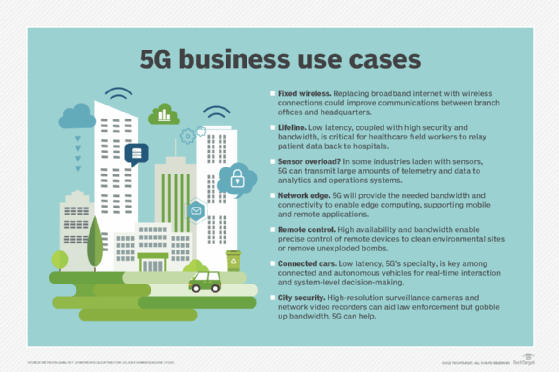
ake78 (3D & photo) - Fotolia
Determine 5G enterprise use cases, cost before deployment
There's a lot of hype surrounding 5G. Before getting too excited, it's important to determine the enterprise use cases, costs and what organizations must do to take advantage of 5G.
5G promises faster speeds, more capacity, superior connectivity and lower latency, but organizations should first understand 5G enterprise use cases and potential issues.
Just as 4G replaced 3G, 5G will replace most 4G implementations and become mainstream technology. Organizations will eventually need to upgrade, but they should be smart about when to make the jump and not just react to the market hype and unwarranted user demands.
5G networks
Most network operators say they already have or will have 5G rolled out this year, but it's important to understand what that means. Many high-traffic areas around major cities have or will have 5G, but it will take some time to filter down to less densely populated areas.
The coverage of 5G-enabled devices depends on what bandwidth the carriers are using. Some carriers deploy implementations on the lower Sub 6GHz bandwidth, which has the widest coverage areas. Many carriers use mmWave bands which works well for densely populated outdoor areas with many cell sites. This bandwidth, however, requires a special mmWave-capable modem in the phone, and not all current 5G-enabled devices have such a chip. Future devices will cover both bands of Sub 6 GHz and mmWave.
But no matter which bands are used, coverage is key. The ability to accessing 5G networks 80% to 90% of the time is likely one to two years away for many users. Users that rely on getting 5G when they need it should be conscious of where they will be using it.
5G enterprise use cases
All users enjoy fast download speeds, but organizations should determine whether the benefits of 5G will provide value to the business. 5G does not offer much advantage to users with simple mobile apps such as forms, where the amount of data transmitted is small and the need for real-time data gathering is minimal. The real 5G advantage comes with deploying complex apps with lots of data, such as with use of video, large data sets, time critical two-way multimedia communications or safety related communications.
With 5G, for example, detectives can record a video interview with a witness and transfer it to the headquarters' servers in a matter of seconds, where it could have taken several minutes on older technology, depending on the length and size of the file. Field service workers can quickly download a complex set of maps for all the utilities in a certain location before they begin an excavation, rather than having to pre-download before leaving the service facility. 5G offers the ability to work at unexpected locations that pop up during the day, and still have an ability to get all the data necessary. Organizations without 5G enterprise use cases will only reap minimal benefits in the short term.

Upgrading to 5G
5G doesn't work without 5G-enabled devices. Most smartphones and other mobile-connected devices such as tablets and laptops are not 5G-enabled unless they are very new. Organizations must determine whether the cost of upgrading devices now rather than at end of life will make a difference, both in terms of total cost of ownership (TCO) for devices and in the need to update existing apps to take maximum advantage of 5G capabilities.
Many current mobile apps sacrifice the amount of data in the download to minimize latency for the mobile app users. This means that sometimes only a minimal data set is sent to a mobile app. With 5G, a much richer set of data can be sent to the app, giving the user a much greater amount of detail on a customer or a contract, for example, but it requires that the app be redesigned to take advantage of this increase in available bandwidth and reduction in latency. Many apps will ultimately benefit from the 5G advantages, but developers will need to update them to maximize the 5G capabilities.
The available 5G devices are still limited and expensive; prices generally start at $1,000. In late 2020, more mid-stream 5G devices in the $500-$600 range will be available. The "big four" mobile carriers will offer the 5G-enabled Samsung Galaxy S20 family of phones, but at a price. The S20 starts at $999, the S20+ is $1299, and the S20 Ultra is $1499.
Creating a 5G strategy
Organizations that plan to deploy 5G devices must first create a deployment strategy. It should include an assessment of which employees and job functions can best benefit from the 5G enterprise use cases today and those that can wait a year or more until it's more mainstream.
IT staff should analyze which apps can most benefit from the speed and lower latency of 5G and which will have minimal advantage from the move, as well as which apps they should ultimately upgrade to take maximum advantage of 5G capabilities.
Finally, IT staff should assess the users themselves and determine which users need to be first-movers, such as high-level executives, high-value employees in the field and high-impact users. This is the only way to obtain a maximum ROI in 5G.






